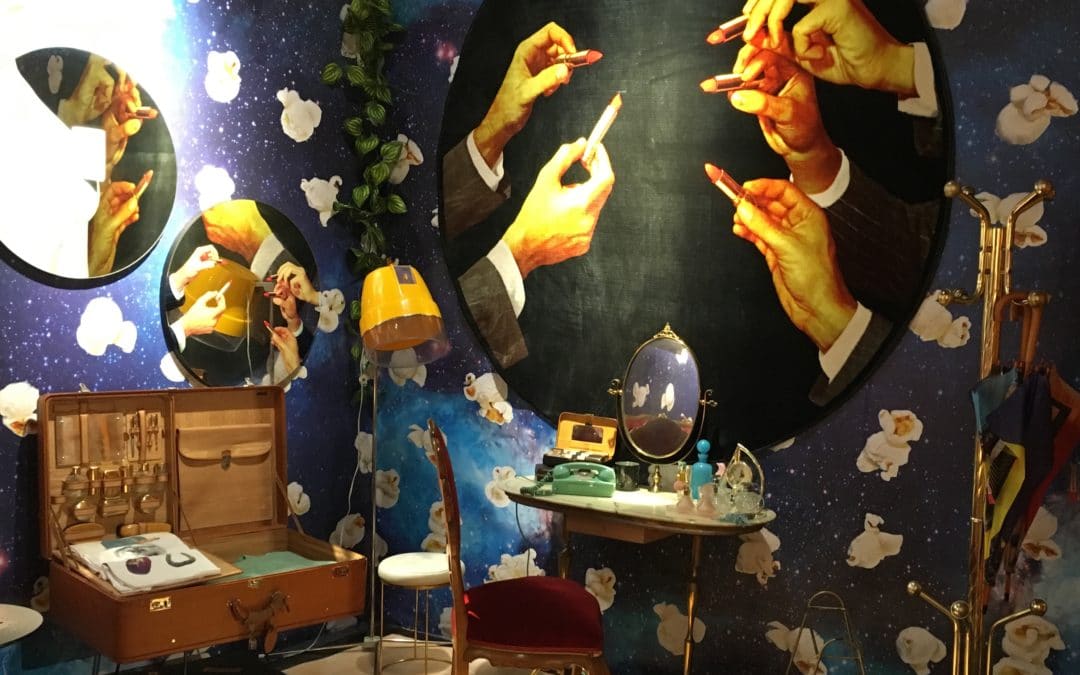
By Ronni Sandroff | Dec. 2016 | Letagemagazine.com
While 20th-century art seemed to dominate the showings at Art Basel Miami this year, a work that was only a month old attracted the most attention. Artist Rirkrit Tiravanija seized the moment and used the November 9th N.Y. Times to make a statement in three huge identical pieces, varying only in that the slogan is printed in red, white or blue. The work by Tiravanija, a Thai-born in Argentina and now based in New York, Berlin, and Chiang Mai, sold immediately after the show opened, according to Art News.
The chaos and irony of our more interior life was highlighted in works such as Psychonavigation by Charlene Von Heyl and Never Kissing You Back by Sean Landers. And, an astonishing apartment installation, commissioned by Fondation Beyeler, the Swiss museum, and created by Italian artists Maurizio Cattelan and Pierpaolo Ferrari’s magazine project, Toilet Paper, was, among other things, an uproarious comment on our sexualized consumerism.
The fair boasted a rich offering of well-known 20th-century masters and a Cabinet showcase on Asgar Jorn, 1914-1973, a flamboyant and little recognized Danish artist.
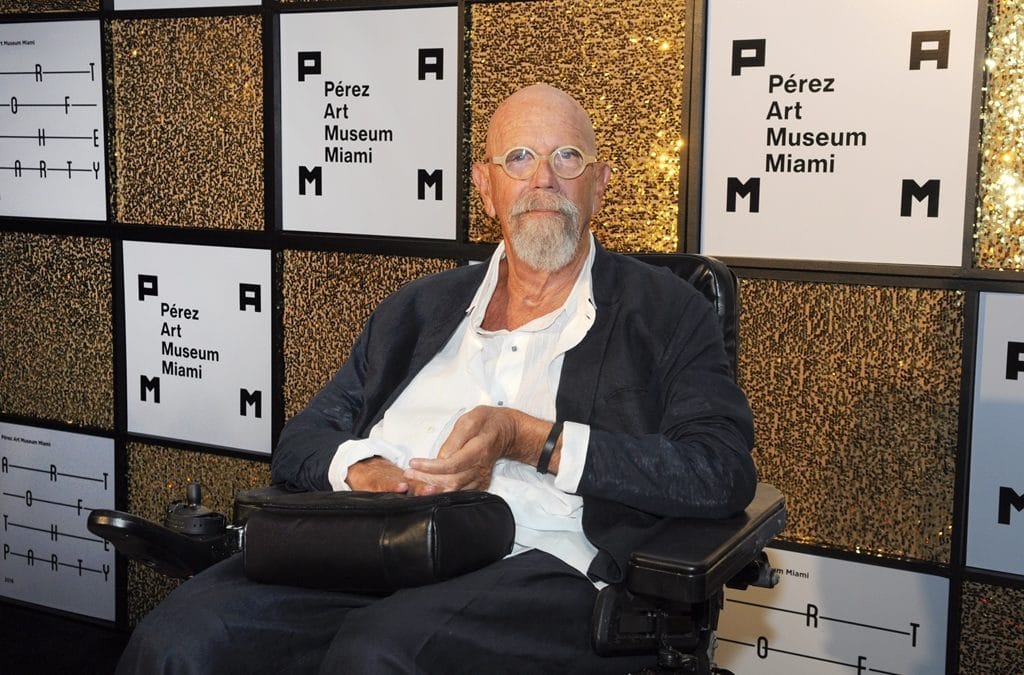
By Ronni Sandroff | Mar. 2016 | Letagemagazine.com
The faces, looming larger-than-life, often staring straight at you, are unguardedly and unglamorously human. They seem so real that you can sense the rumble of the person’s thoughts. Yes, the paintings and photographs of renowned New York artist Chuck Close, 76, can take some getting used to. When you view a photograph, it’s as if you’re staring deep into a person that you suddenly know all too well.
Close has photographed, painted, woven, and imaginatively reinterpreted many times, a core set of almost wall-size portraits. The colorful pixelated painting versions are the most ravishing – and yield a series of different visions as you walk toward and away from them. But though Close can border on the abstract, the strong gaze of his subjects bores through. The subjects (including himself) have almost blank expressions and don’t overtly show emotion. They seem unposed, and somehow objective.
At the March 4 PAMM Art of the Party gala in Miami, which honored the artist, Close answered a few questions for L’Etage Magazine that I’ve long wondered about.
When you’re doing a portrait, do you consciously try not to “editorialize” about the person who is the subject of your work?
Chuck Close: I try to be rather neutral and flat-footed, but I’m sure there’s some editorial work in there somewhere. I don’t flatter anybody, but I also don’t try to make them look worse. No matter how much they hate it when I do it, ten or 15 years later they think they look pretty good.
Even in your portraits of well-known people, such as Kate Moss and Justin Timberlake, we see an unfamiliar side of them. How do you work with models to achieve this?
Chuck Close: I don’t let them put on makeup, and I don’t do photoshop. There’s something kind of wonderful about people before they try to improve themselves. There’s a certain kind of honesty to it. When I apologized to Kate Moss, she said: “oh its ok I’ve had a million pretty photos taken.” (Laughs)
You’ve said your favorite painter is Johannes Vermeer. His faces also often have enigmatic expressions. Can you talk about how he has influenced you?
Chuck Close – I think I can figure out how any painting in the history of the world was made except for Vermeer’s. (His paintings) are like an apparition. Just magical. It’s the fact that they’re so special that impresses me. I never care about the story. I’m a formalist. I don’t care who the letter (in Vermeer’s “Woman in Blue Reading a Letter”) is from. It’s like he paints blue on the canvas in a divine breath.
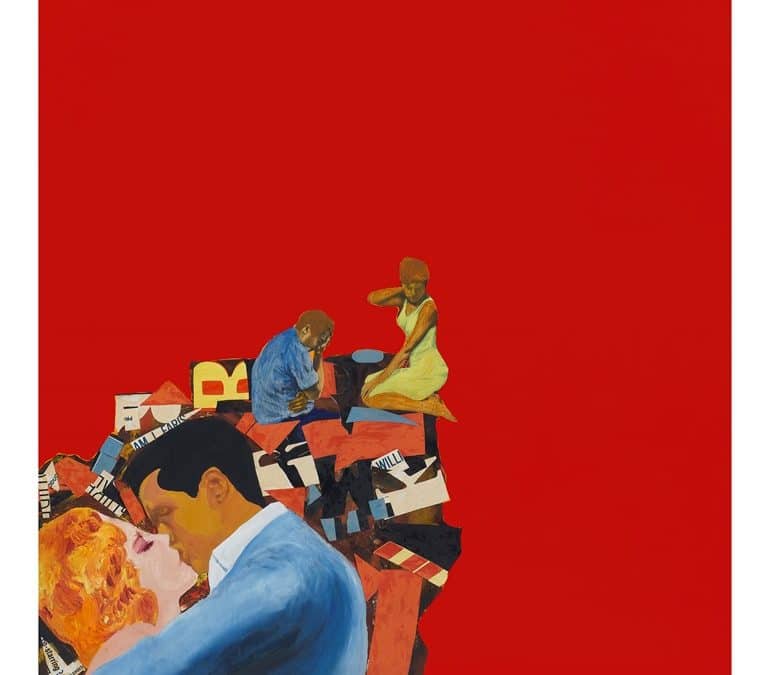 “If you want a message, get a fortune cookie,” veteran pop artist Rosalyn Drexler laughingly told L’Etage Magazine when she was asked what she thought the many women artists displayed at this year’s Art Basel Miami might have in common. “I come to art not looking for anything and I find it,” said Drexler during her Art Basel DIALOG event at the convention center on December 4th.Drexler, who is suddenly selling paintings after decades of neglect, is wary of being femcast. But she acknowledged that works by women artists were considered unsellable in the 1960s. At the time, she says she didn’t quite understand that men were in and women were out. Warhol did a series of Drexler in a wrestling stance (she did a tour as a woman wrestler, her means of going on the road) in “Albums of a Mat Queen 1962.”
“If you want a message, get a fortune cookie,” veteran pop artist Rosalyn Drexler laughingly told L’Etage Magazine when she was asked what she thought the many women artists displayed at this year’s Art Basel Miami might have in common. “I come to art not looking for anything and I find it,” said Drexler during her Art Basel DIALOG event at the convention center on December 4th.Drexler, who is suddenly selling paintings after decades of neglect, is wary of being femcast. But she acknowledged that works by women artists were considered unsellable in the 1960s. At the time, she says she didn’t quite understand that men were in and women were out. Warhol did a series of Drexler in a wrestling stance (she did a tour as a woman wrestler, her means of going on the road) in “Albums of a Mat Queen 1962.”
“I was a good-fellow and I appreciated Andy Warhol and Roy Lichtenstein,” Drexler said. “When I was in the company of artists, I didn’t mention myself.” Unfashionably for the times, Drexler’s canvases were warm with feelings, often uneasy ones. “Emotional content was a no no for Warhol and Lichtenstein,” she said. “There were a lot of drugs. Everything was marvelous. They managed to have no pain but only images of it.” As an artist, playwright (she won three Obie awards), writer, wife and mother, Drexler says she didn’t have time for drugs. And she believes pain is important for art.Her powerful “Marilyn Pursued by Death,” 1963, is frightening, and one of a very few Marilyn images that do not now seem exploitative. Like Warhol, Drexler appropriated images; hers came from movie posters, sports illustration and television. “A real thing happens so it can be appropriated as a reminder,” she said.Another gripping painting is a grim reminder of the “Death of Benny “Kid” Paret 1963,” a Cuban welterweight boxer who died from injuries sustained in a televised match. The painting consists of six small televised shots of the boxing match against a black background which seem to capture the sinister action as well as the flashing of the tv screen.Her process was to find an image that interested her and work it up on different size canvases. “The size also works emotionally on the subject matter,” she said. She made collages and painted in vivid colors over and around the images. “The image lives more when I paint over it,” she said, “The intent is mine.”Its hard to know how seriously to take Drexler’s discussion of “The Dream,” a work that pairs a rageful movie-poster gorilla and a terrified brunette. “A beast can have love for a creature,” she said. “The woman is terrified, the gorilla is an action guy. Its about violence and love, and forbidden love.” Then she noted: “I was always an outsider laughing at my own ideas.”
The irrepressible Ms. Drexler, now 89, talked at DIALOG with Christopher Bedford from the Rose Art Museum in Waltham, MA. The museum will be hosting a retrospective of her work, “Rosalyn Drexler: Who Does She Think She Is?” from Feb 12-June 5, 2016.
Garth Greenan, Director, Garth Greenan Gallery, New York that displayed Drexler’s work in Art Basel’s Survey sector, said it was the perfect platform for overlooked or under-appreciated artists, and that Drexler’s work seems to be finally getting the recognition it deserves and is being placed with major institutions.
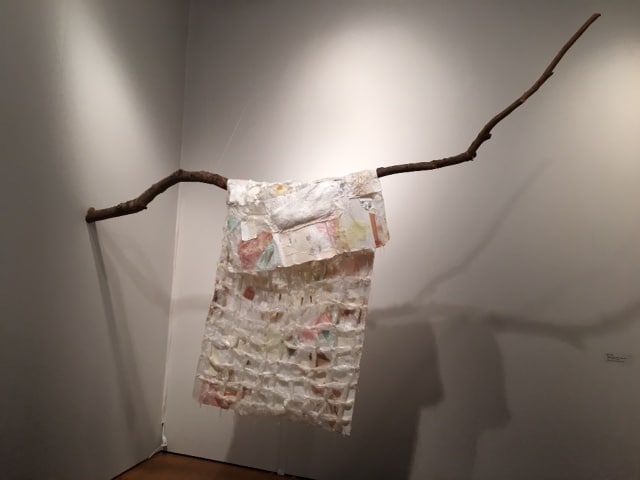
By Ronni Sandroff | Mar. 2016 | Letagemagazine.com
Some of my favorite pieces in the 42 galleries exhibiting at the first annual Art Boca Raton were both on and off the wall, which produced a dynamic energy. Among the most striking was Helen Lopez “Alone in My Little World, 2015” in which a tree branch breaks out of a wall and is hung with a beautifully textured collage. Lopez is identified as a student, which also took breath away.
The wall sculpture artists at the show used an eclectic array of materials, and many pieces hang enough off the wall that their shadows become part of the art. Slip Casted porcelain was used by Natalia Arbelaez to form five expressive human heads, in “Insignificant Grandeur (self-supporting heads). “Tooling Around” a 21 x 57 mixed media by Elayna Toby Singer, is made mostly of metal. And Maximilano Pecce’s exuberant motorcycle, “On My Way” is made of melted plastic. Painted laser cut steel forms Tom Wesselmann’s “Steel Drawing-Sitting Nude” 1986-87. It does have the fluidity of a drawing with a beckoning touch of dimensionality.
Moving from off the wall to on the table, Sam Tufnell’s beautiful “Wynwood Resurrection” 2016 is made of cast resin with lighted pedestal included. And, I was delighted by Alfredo Sosabraovo’s colorful and comic Murano glass sculpture, and even more amused when I saw the title: “Bureaucrat.” I especially liked the birds perched on the bureaucrat’s skull.
There are also plenty of interesting paintings to see, including a large showing of Russian Boris Alexandrovich Chetov’s (1926-2010) easy to take expressionism, cubism, and abstractions. Art Boca Raton runs through Monday, March 21, 11-6 pm, at the International Pavilion of the Palm Beaches, Research Park at Florida Atlantic University 3450 NW 8th Avenue, Boca Raton.
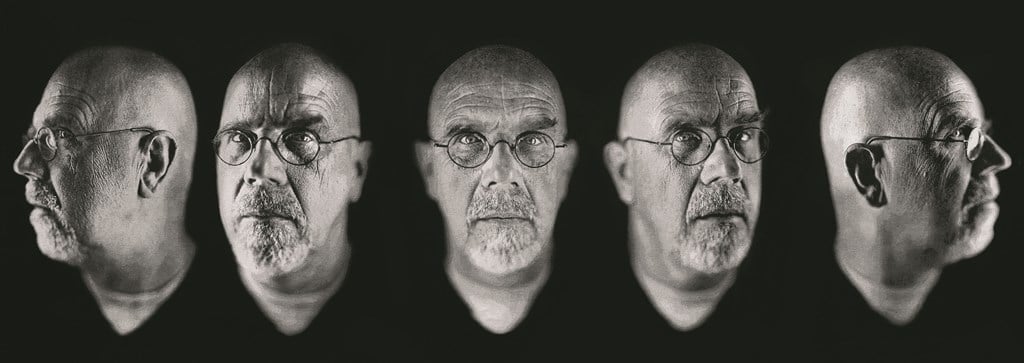
By Ronni Sandroff | Mar. 2016 | Letagemagazine.com
“Who is going to buy a nine-foot painting of someone they don’t know?” a gallery owner asked painter Chuck Close at the start of his career. “Don’t worry,” Close replied, “They’ll all go to museums.”
This story was recounted in an opening night talk by Terrie Sultan, Director of the Parrish Art Museum, Water Mill, NY, which originated the “Chuck Close Photography” exhibit that is now at the NSU Museum of Art Fort Lauderdale until Oct 2nd.
Grandiose from the start in both the scale of his work and his self-confidence, museums are indeed the perfect venue for Close’s monumental works. The show offers a generous display of Close’s large-scale nudes and portraits taken (sometimes in sections) with a large-scale Polaroid camera. Also included are some innovative daguerreotypes, a 19th-century technique which Close modernized by using banks of strobe lights. The process behind his productions are unveiled through an exhibit of contact sheets, proofs and photographs scored with ink and masking tape.
As Terrie Sultan remarked, “Close’s nudes seem strangely unsensual, yet when he occasionally turns his attention to flowers, the photographs are downright sexy.” Close’s subjects are mostly himself, friends and family, but he also turned his lens to well-known people. The shows includes portraits of Kate Moss, Alec Baldwin, Bill and Hillary Clinton as you’ve never seen them.
A nice relief from Close’s soul-baring close-ups is the Museum of Art’s downstairs exhibit: “Bellissima: Italy and High Fashion 1945-1968 (through June 5th), presented by Bvlgari. It was a great era for fashion, and I wanted all the clothes. Be sure to watch the clips from Italian films of that era, where stunning outfits are worn by women shooting handguns or traipsing through fountains in Fellini films.





